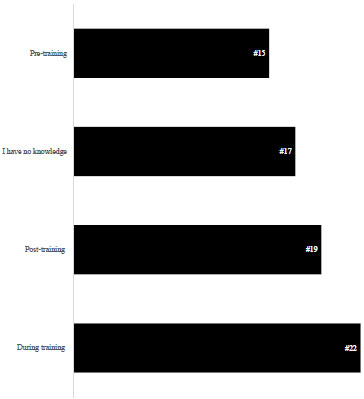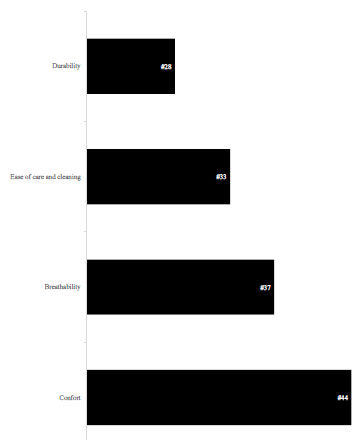All published articles of this journal are available on ScienceDirect.
The Post-Exercise Lower Limbs Recovery Process: A Questionnaire Applied To Physiotherapists
Abstract
Background:
Physical exercise is essential to improve quality of life, with muscle recovery after exercise being crucial since it reduces the delayed sensation of muscle discomfort and fatigue. The present study aims to identify the methods used by physiotherapists to recover sports practitioners after physical exercise and presents a non-experimental, quantitative and descriptive nature.
Methods:
Fifty-two physiotherapists (52% women), with 9.8 ± 7.3 years of experience and different sports backgrounds, were asked to complete an anonymous questionnaire that consisted of (1) participant demographics, (2) recovery wearable sports garment, and (3) development of a new product for muscle recovery.
Results:
Physiotherapists reported that sports practitioners use legging-like garments during training (n=22), after training (n=19), while some physiotherapists were not aware if their athletes use any legging-like garment (n=17). The common characteristics of the garments are the compression (56%), heating (34%) and, in some cases, massage (6%) and printed electronic devices (4%). Physiotherapists mention that sports practitioners usually report lower limbs localized muscle fatigue after training or competition (90%), and the most affected areas are the entire lower limb (n=12), quadriceps (n=9) and hamstring and glutes (n=7 each). The most common therapy used is massage (n=12), followed by electrostimulation (n=8) and compression (n=5).
Conclusion:
Physiotherapists believe that electrostimulation should be used to recover quadriceps, hamstrings and the whole lower limb, and localized heating should be centered in the entire lower limb, hamstrings and quadriceps (in number of answers). Alternatively, massage is better to recover the whole lower limb, gastrocnemius, and hamstrings. When asked what characteristics the garment should have, physiotherapists reported that comfort (n=44), breathability (n=37) and ease of care and cleaning are vital.
1. INTRODUCTION
Evidence shows that physical exercise provides broad benefits, reducing feelings of anxiety and depression, improving sleep and life qualities, and decreasing the risk of developing diabetes, heart disease and cancer [1]. Post-exercise recovery aims to restore human body systems to the baseline condition, promoting homeostasis and reducing the consequent delayed sensation of muscle discomfort and fatigue [2, 3]. The incomplete or inadequate recovery or even its absence can lead the practitioner to not perform the subsequent training with the required quality. In addition, high fatigue levels can predispose the practitioner to injury [4], evidencing the post-exercise muscle therapy importance as a valuable tool to optimize gains in the training process functionality. In addition to low intensity exercise, frequently used for active recovery [5], the methods commonly used for post-physical stimulation are the electrostimulation [6, 7], compression [8], massage [9, 10], cryotherapy [11], heating [12, 13] and contrast [14].
Physiotherapeutic treatments aim at accelerating and improving the process of post-exercise restitution, as well as injury prevention, treatment of already existing injuries, compensation of muscular dystonia or improving movement quality [15]. According to the same author, the application of physiotherapeutic support is a common phenomenon regardless of the sports discipline or years of training. To this, the research project Wear2Heal aims to develop traceable textile solutions for the lower limbs, integrating localized electrostimulation, massage, compression, and active heating [16].
Currently, the materials available for post-exercise recovery do not integrate all therapies. In addition, textile products are scarce and do not affect the entire lower limb [17]. Although the market has generous offers, the electrostimulation related materials have little durability [18]. Regarding compression and massage, the existing clothing is related to venous insufficiency and causes restrictions on the users’ mobility [12]. Complementarily, there is no adequate equipment to monitor the temperature during heating procedures, with poor breathability also being a significant limitation [19]. Therefore, to develop new wearable garment solutions help to reach the desired performance levels, it is essential to survey the methods used by physiotherapists to recover sports practitioners after physical exercise.
The aims of the current study were: (i) to identify the type of clothing used in physical exercise and its most relevant characteristics; (ii) to determine which areas/muscle groups are reported to have greater discomfort, fatigue or pain during physical exercise; (iii) to comprehend the used therapies promoting the respective post-exercise recovery; and (iv) to understand the receptivity of the target audience regarding the development of leggings with integrated intelligent systems for muscle post-exercise recovery.
2. METHODS
The current study presents a non-experimental, quantitative and descriptive nature, and was conducted according to the guidelines of the Declaration of Helsinki by the World Medical Association [20] and approved by the Institutional Ethics Committee (CEFADE) with the project ID: POCI-01-0247-FEDER-039918. A questionnaire was used as a data collection instrument, allowing researchers to collect information from different physiotherapists as well as to standardize the assessment. For applying the questionnaires, personal contact with the participants was privileged (An experienced male investigator (PhD) with more than ten years of practice applied the questionnaires). Once it was clarified that the study participation was voluntary and that the participants' right to privacy, confidentiality and anonymity would be granted, the study goal was presented. In addition, doubts concerning the response system were answered. The questionnaires were applied in digital format (via link) to a convenient audience. All met the necessary conditions for admission. The Consolidated Criteria for Reporting Qualitative research (COREQ) checklist was followed [21].
2.1. Participants
The eligible sample consisted of 52 physiotherapists, 27 females and 25 males (52 and 48%, respectively) with 9.8 ± 7.3 years of physiotherapy experience. Physiotherapists registered for the PhD degree at the University of Proto, understood Portuguese and agreed to complete the questionnaire were eligible for inclusion. Therefore, no exclusion criteria were applied. These physiotherapists were familiarized with practitioners from different sports, particularly handball, athletics (running, march and triathlon), kickboxing, basketball, cycling, cross-training, football, futsal, gymnastics, swimming, roller hockey, rowing, rugby, surf and volleyball.
2.2. Instrument: Questionnaire to Survey Physiotherapists' Therapies Regarding Exercise Recovery
An anonymized online survey was designed, piloted, and advertised widely from March 2021 to September 2021. The questionnaire consists of the following three sections: (i) A, consisting of personal information and two characterization questions; (ii) B, with seven items, aimed to identify the type of clothing used in physical exercise and their most relevant characteristics, as well as which areas/muscle groups are reported to feel in greater discomfort, fatigue or pain and the current therapies used to promote the respective recovery; (iii) C, including two items, aimed to understand the receptivity of the target audience regarding the development of a new product for muscle recovery - leggings with integrated intelligent systems. Several questions allowed multiple answers.
2.3. Analysis
All statistical analyses were performed using Statistical Package for Social Sciences, version 26.0 for MAC OS X. Descriptive statistics were used to analyze the data from the questionnaires and reported as frequencies, percentages, and means as appropriate. The figures production was carried out using Microsoft Office Excel 2016 software.
3. RESULTS
From the 52 questionnaires answered, it was observed that 35 physiotherapists confirmed the use of wearable sports garments by the athletes that they work with. Fig. (1) represents the use of legging-like garments in exercise by the athletes.
From the obtained questionnaires, the most affected body areas were the entire lower limb, quadriceps, hamstring and glutes (Fig. 2).
Fig. (3) presents the suggested characteristics according to physiotherapists` experience and knowledge.
4. DISCUSSION
This study aimed to understand better the used physiotherapies related to smart garment leggings with integrated intelligent systems for muscle post-exercise recovery. To this, the current study surveyed the requirements and essential characteristics of the lower limbs clothing used in physical exercise and the recovery phase. Thirty-five physiotherapists confirmed their athletes' use of wearable sports garments; during training (42%) and after training (37%). Some physiotherapists were unaware if their athletes used any garment (33%). This type of clothing was less common in pre-training (29%) than during and post-training (Fig. 1).

Regarding the legging-type garments' most relevant features, characteristics such as compression (56%) and heating (34%), as well as, smaller scale, massage (6%), and printed electronic devices (4%) were highlighted. On the other hand, sixteen physiotherapists (31%) reported no knowledge of the characteristics of legging-type garments, while 2% did not use any legging-type garment. Furthermore, athletes frequently report lower limbs localized muscle fatigue after training or competition [2, 3], a fact that 90% of physiotherapists have also highlighted.
Running motor activity is not limited to the lower limbs' action, but the significant muscle preparation and recovery issues are mainly centered on this body part [4]. The main muscle groups responsible for mobilizing the ankle (medial gastrocnemius and lateral/soleus gastrocnemius as foot plantar flexors, and tibial anterior as foot dorsal flexors), knee (quadriceps and hamstrings responsible for knee extension and flexion, respectively) and hip (iliac psoas and lower abdominals acting as hip flexors, and small, medium and large glutes as hip extensors) joints, are the object of central intervention, whether in terms of heating [13], electrostimulation [18] and massage [10].
The regions of most significant interest to study in the literature have focused on the ankle and calves regarding the use of compression socks or garments [22]. Regarding whole lower limbs, improvements were identified in the oxygenation of the calves during continuous running [23]. In addition, in the quadriceps muscle group, more precisely in the vastus lateralis, during high-intensity interval running [8, 24] also identified that exercisers might benefit from compression during intense, repeated exercise with short rest periods. The most common therapy used in post-exercise practice was also the study object, and the current study intends to comprehend the used therapies promoting the respective recovery. The most common therapy reported was massage (n=12), followed by electrostimulation (n=8) and compression (n=5). In decreasing order of mentions, physiotherapists believe that electrostimulation should be used to recover the quadriceps, hamstrings, and the whole lower limb, while localized heating has a different gradient: whole lower limb, hamstrings, and quadriceps. Alternatively, massage is better for recovering the whole lower limb, gastrocnemius, and hamstrings [10].


5. CONCLUSION
The final aim was to understand the receptivity of the target audience regarding the development of leggings with integrated intelligent systems for muscle recovery. We propose to develop solutions to support muscle recovery as a supporting motor activity for different sports. In the Wear2Heal project, the innovation will be the development of textile structures provided with the capacity for electrostimulation, massage, compression and localized heating, based on printed electronics and conductive wires/fibers [25]. Furthermore, innovation will also be associated with the relevance of a system for configuring therapeutic parameters (mobile application) since most respondents mentioned that it would be highly relevant. When asked what characteristics the garment should have (Fig. 3), physiotherapists reported that comfort (85%), breathability (71%), ease of care and cleaning (64%) and durability (54%) are vital, while design (17%) and fitting (31%) are less critical.
ETHICS APPROVAL AND CONSENT TO PARTICIPATE
The current study was approved by the Institutional Ethics Committee (CEFADE) with the project ID: POCI-01-0247-FEDER-039918.
HUMAN AND ANIMAL RIGHTS
No animals were used for studies that are the basis of this research. All the humans were used in accordance with the ethical standards of the committee responsible for human experimentation (institutional and national), and with the Helsinki Declaration of 1975, as revised in 2013 (http://ethics.iit.edu/ecodes/node/3931).
CONSENT FOR PUBLICATION
For applying the questionnaires, personal contact with the participants was privileged (An experienced male investigator (PhD) with more than ten years of practice applied the questionnaires). Once it was clarified that the study participation was voluntary and that the participants' right to privacy, confidentiality and anonymity would be granted, and the study goal was presented.
STANDARDS OF REPORTING
The Consolidated Criteria for Reporting Qualitative research (COREQ) checklist was followed [21].
AVAILABILITY OF DATA AND MATERIALS
The data supporting the findings of this study is available at: 10.6084/m9.figshare.20406144.
FUNDING
None.
CONFLICT OF INTEREST
Dr. Ricardo Fernandes is the Editorial Advisory Board Member of The Open Sports Sciences Journal.
ACKNOWLEDGEMENTS
Declared none.


